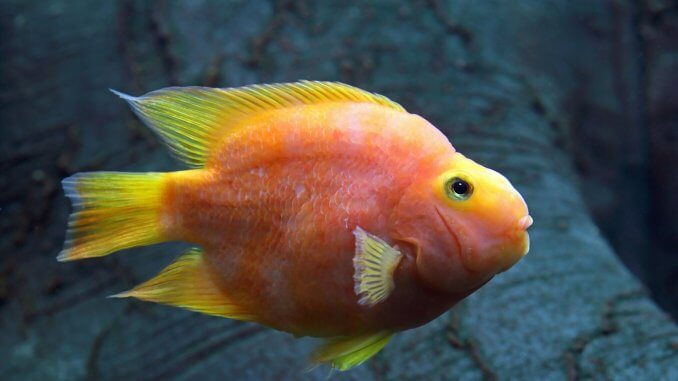
The blood parrot cichlid is a freshwater fish of the cichlid family. Blood parrot cichlids are hybrids between the redhead cichlid and midas cichlid. Blood parrot cichlids have beak-shaped mouths with googly eyes, broad fins, and bright orange scales.
A blood parrot cichlid is a peaceful fish that works well in community tanks. Blood parrot cichlids are popular because they’re beautiful and can recognize and respond to aquarists. However, the fish is unpopular with some aquarists due to its intermediate care level and its hybrid breeding, which causes genetic deformities.
TABLE OF CONTENTS
Blood Parrot Cichlid Facts & Overview
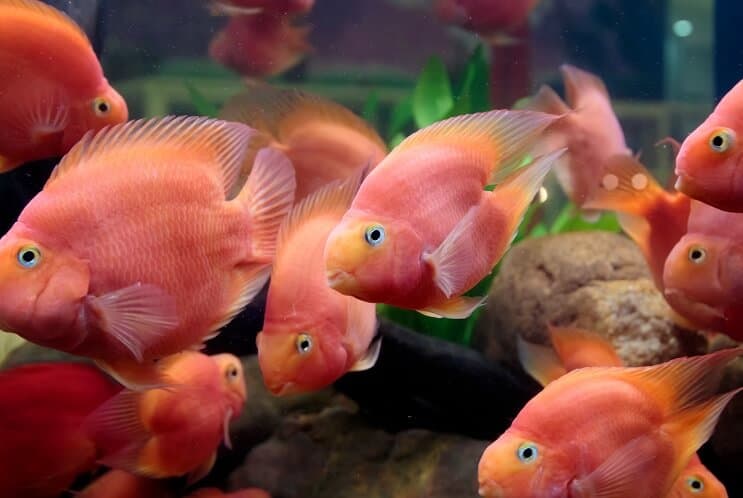
| Scientific name: | Amphilophus citrinellus x Heros severus, Amphilophus citrinellus x Paraneetroplus synspilus |
| Common names | Blood parrot cichlid, blood-red parrot cichlid |
| Distribution: | Taiwan |
| Size: | 7–8 inches |
| Life expectancy | 10–15 years |
| Color: | Bright orange, yellow, red (gray is rare) |
| Diet: | Omnivore |
| Temperament: | Peaceful |
| Minimum tank size: | At least 30 gallons |
| Temperature: | 76–80°F (24.4–26.6°C) |
| pH: | 6.5–7.4 |
| Hardness: | 3.3–6.6 dGH |
| Care level: | Intermediate |
| Breeding: | Challenging because most males are sterile |
Origin
The blood parrot cichlid is a hybrid species originating from Taiwan in 1986. The Taiwanese bred the Costa Rican midas cichlid (Amphilophus citrinellus) with the Mexican redhead cichlid (Paraneetroplus synspilus). Both cichlid parents were freshwater fish from rivers and basins.
Blood parrot cichlids also come from the hybrid between midas cichlids and banded cichlids (Heros severus) from South American freshwater basins. Blood parrot cichlids aren’t found in the wild.
Adult Size & Lifespan
Blood parrot cichlids are one of the larger cichlids. Adult males reach 8 inches, while adult females reach 6 inches long. Blood parrot cichlids live 10 to 15 years. Their lifespan depends on an aquarist’s care and the fish’s living conditions.
Availability
Blood parrot cichlids are challenging to find in pet stores. Some exotic pet stores keep hybrid cichlids. Blood parrot cichlids range from $9.99 to $61.99. Find blood parrot cichlids at these online stores:
Appearance & Behavior
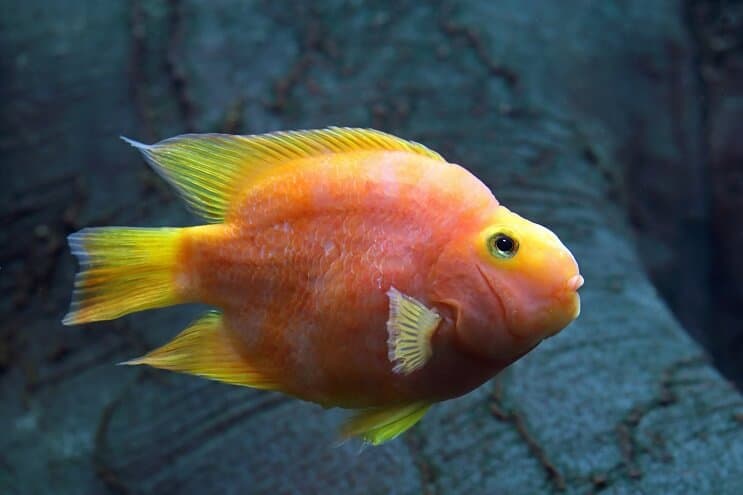
A blood parrot cichlid gets its name from its beak-like head and large eyes that look like a parrot. These cichlids are peaceful community fish with shy natures.
Colors, Patterns, Fins, and Sex Differences
A blood parrot cichlid has a beautiful bright orange body with cascading translucent fins. Some of these fish are yellow and red, and the rarest color is gray. Some breeders unethically dye their fish to obtain new colors, shortening the fish’s lifespan.
Blood parrot cichlids are easily recognized by their large eyes, broad fins, and parrot-style beaks. Adult males are longer and slimmer than females, while females have plumper bodies.
Unfortunately, the blood parrot cichlid has genetic deformities from hybrid breeding. The fish’s nuchal fins are enormous compared to its head. The blood parrot cichlid’s small mouth opens vertically and cannot close properly, and it has a row of teeth going down its throat, which obstructs eating.
The mouth also makes self-defense more difficult, which is a problem if the fish is housed in a tank with aggressive fish.
Common appearance changes when blood parrot cichlids are ill or stressed include:
- Swollen body
- Cloudy eyes
- Increased mucus production
- Color fading
Typical Behavior
A blood parrot cichlid sleeps at night, surfs the substrate for food, loves hiding in caves during the day, and swims around the middle of the tank. These fish even recognize their owners.
Blood parrot cichlids are peaceful when surrounded by community fish and the tank has enough space. The fish becomes aggressive under stress or when housed with aggressive fish, and it acts territorial in an overcrowded tank — the species is known to nip at other fish’s fins if the tank is crowded or if the other species in the tank are aggressive.
Behavioral signs that these fish are ill or stressed include:
- Scratching against tank sides or decorations
- Loss of appetite
- Lethargy
Blood Parrot Cichlid Care & Tank Requirements
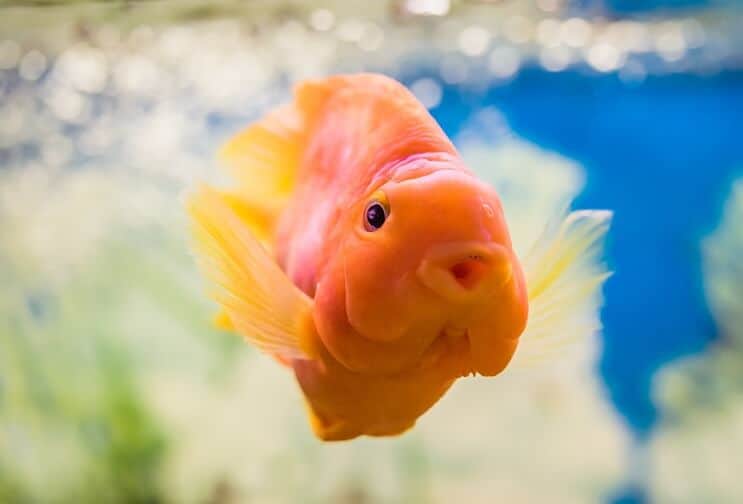
A blood parrot cichlid is best kept by at least intermediate aquarists because the fish requires specific tank conditions. This species has no natural habitat, so aquarists should closely follow experts’ recommendations on food and tank requirements.
Habitat and Tank Requirements
Blood parrot cichlids are hybrid fish with specific needs that need to be met to keep them healthy. Both parent cichlid fish come from freshwater basins and rivers with plenty of space, so a blood parrot cichlid’s tank should contain a soft substrate to replicate river sand.
Change 20% of the water once a week because blood parrot cichlids produce plenty of waste. Water changes keep the fish healthy and happy.
Tank Conditions
| Water type: | Freshwater |
| Tank size: | Minimum 30 gallons, add 10 gallons for each additional blood parrot cichlid |
| Water temperature: | 76–80°F (24.4–26.6°C) |
| Substrate: | Fine gravel or sand that the fish can dig in |
| Tank setup: | Driftwood, clay pots, java fern, hornwort, and anubias |
| Acidity: | 6.5–7.4 pH |
| Water hardness: | 3.3–6.6 dGH |
| Filter: | Yes, because this species produces a lot of waste |
| Bubbler: | Not essential |
Blood parrot cichlids have specific tank requirements, including the following:
Blood parrot cichlids remain healthy when the right tank conditions are maintained. This fish has the most beautiful coloration in the proper temperatures, lighting, and acidity levels.
Disease
Blood parrot cichlids are prone to some illnesses, including the following:
- Ick parasites: Caused by a type of fish lice that appears as white spots on a fish. High amounts of nitrate and ammonia cause ick parasites. Prevent parasites on cichlids by maintaining appropriate tank conditions. Treatment involves temperature changes, increased salinity, quarantine, and chemical treatments, depending on the severity of the infection.
- Bacterial infections: Can occur due to injuries from rocks, coarse substrate, and fights with aggressive fish. The best prevention is to keep the tank clean and house the fish with peaceful fish. Fin erosion, lethargy, and discoloration are signs of bacterial infections. Treatment includes quarantine, potassium permanganate, and temperature changes.
- Swim bladder disease: Typically affects blood parrot cichlids when they eat the wrong food. Prevention is as simple as feeding them the correct food. The first sign is the fish floating differently, sometimes on its side. Swimbladder treatment includes changing diet by adding bloodworms, brine shrimp (for extra protein), and shelled peas for six weeks. An Epsom salt bath is the last resort.
Tank Mates
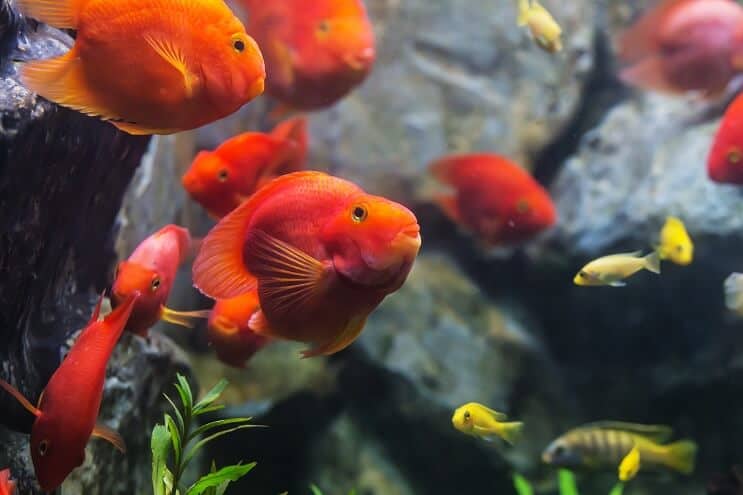
Blood parrot cichlids are excellent community fish when housed with other peaceful fish or fellow blood parrot cichlids. Never house this species with aggressive fish. Great tank mates for blood parrot cichlids include:
- Danios
- Medium tetra
- Catfish
- Angelfish
- African cichlid
- Firemouth cichlid
- Kribensis cichlid
- Honey gourami
- Dwarf gourami
- Clown pleco
- Tiger barb
Diet and Feeding
Blood parrot cichlids don’t exist in the wild, so they don’t have a natural diet. The best food for this speices is a varied diet including both pellets and protein. Dry formulated cichlid pellets work well. For protein, feed the fish high-protein bloodworms and brine shrimp three times a week.
Blood parrot cichlids can’t eat from the water’s surface, so use sinking pellets. Limit the feeding time to a few minutes, three times a day. Remove the excess food to maintain proper water hygiene.
Breeding
Breeding two blood parrot cichlids is rare because the males are typically sterile. However, females still lay eggs, and the eggs can be fertilized by a rare fertile male blood parrot cichlid or by another cichlid species male. Avoid breeding with other cichlid species to avoid unknown hybrids.
Male and female blood parrot cichlids dance around each other when they’re ready to mate. To help the pair spawn, ensure the correct tank conditions are being maintained — the ideal temperature is 76°F to 80°F and the acidity should be 6.5 to 7.4.
The female becomes fatter and finds a hard, flat surface to lay her eggs, if mating is successful.
The breeding pair protect the eggs by sticking around until the fries spawn, eating the fry if they get infected with fungus.
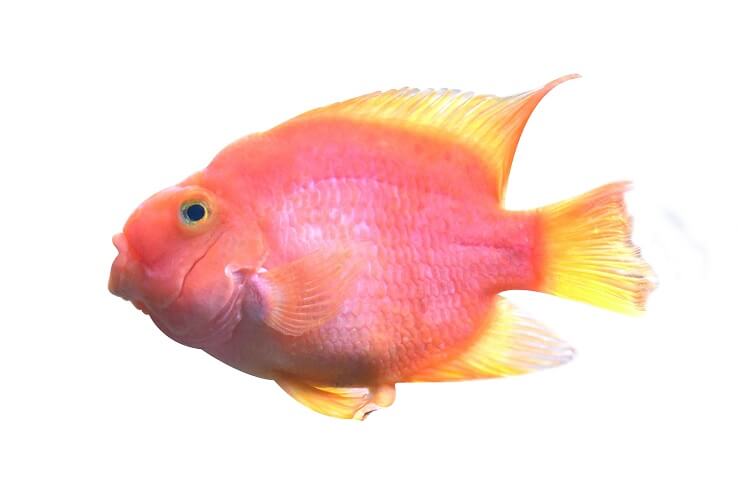
Should You Get a Blood Parrot Cichlid for Your Aquarium?
Blood parrot cichlids are gorgeous, colorful, and bird-like fish that live peacefully with other community tank mates. These active fish create beautiful color streaks in an aquarium as they swim. The blood parrot cichlid’s good memory makes the fish popular with aquarists who enjoy interacting with their pet.
However, consider the slightly high-maintenance food and tank requirements before purchasing a blood parrot cichlid, and don’t get one of these fish if the tank already contains aggressive species.

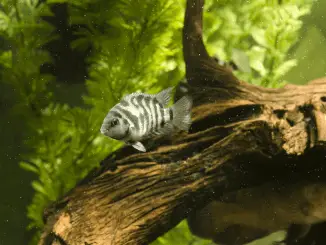
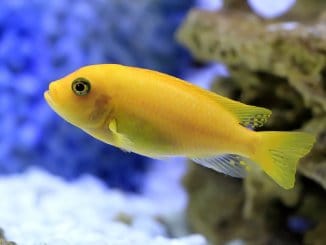
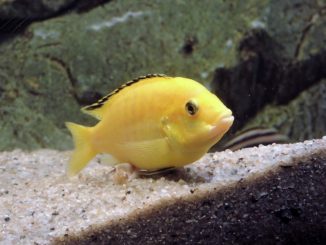
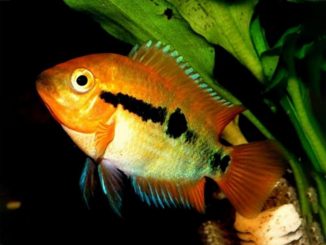
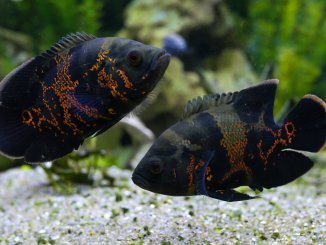
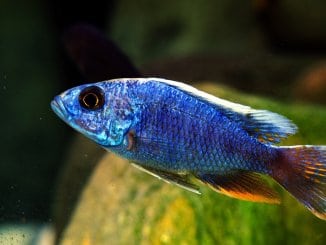
Good read, thank you! I have two Blood Parrots in my 75 gallon community tank. They are doing great! I enjoy watching them swim about, as they seem a bit mischievous. Other times, they can be seen hiding in their terra cotta pots or alongside the planted driftwood. My tank is heavily planted, and they share this space with a female Dwarf Gourami, Bolivian Rams, Cory Cats, Oto Cats, and Harlequin Rasboras. Very relaxing to watch all of them. :)
I’m tucan I had blood parrot cichlids before they are fun they like to play peekaboo and watch cartoons we must protect theblood parrot cichlids from purists sites like (WETWEBMEDIA) and others.????????????????
Thank you for the nice article! My parrots live in a well planted 150 gallon aquarium with 2 Opaline Gouramis , 2large silver dollar tetras, a small school of emperor tetras, a Bala shark, a Pictus cat and two Kribensis cichlids. I rescued mine from a department store where they were trying to escape death by Malawi cichlids. They were only the size of a quarter at that time with fins nipped up. I started them in a 36 gallon, then a 55 g and because they are smart and tame and funny, I ended up giving them the 150! Yes they are my favorites. Very peaceful. Loves peas and frozen worms
Hi Reva gray I’m happy for your bloodparrot cichlids I hope they like watching cartoons ????????
Had 2 Blood red Parrots that lived for 9 years. They were great pets and they recognized me. They always rearranged their tank, including the rocks.
i just got a parrot and i had to remove him from my 200gal it was a tacking everything in the tank, i have a 200gal cichlid tank with 2 big oscars my parrot is about 7 inches and it was atacking my oscars and the 18″ pleaco that is in the tank EXTREAMLY AGGRISIVE fish
I don’t know that I’m blowing the mind of the fish community here but since these are a “test tube” fish I can provide a little more info about the blood parrot. Keep in mind I am not a biologist but have kept a healthy aquarium my entire life. The majority of info you can find about this fish is pretty accurate in my experience (including this article). There are however exceptions, at least in my case. They are relatively peaceful if you give them their own place to hang out in the tank and they are oddly personable. My tank is in a high traffic area of the house and she always fallows me when I walk by, she eats out of my hand, etc. she’s like a dog, and she is exactly 8inchs. 2 things that might need updating are the lifespan and the temperament. I was not even aware my fish was female until she was 13 and I added a group of blue/Bolivian rams to my tank. At that point she started laying eggs once a month for over two years and when she did there was nothing peaceful about her. She divided my tank in half and attacked everything in my tank that crossed that line…including me if I put my hand in to clean it or fixed what she bulldozed over. Lol, the other thing is the lifespan, my parrot is at minimum 17 years old but probably closer to 18 and I know that for a fact. I had a collage roommate I lived with for 1 year in 2003 who loved my fish tank and while in class one day he went to of all places Wal-Mart and bought this fish. She was maybe 1.5 inch long and was died that baby blue color (which lasted a few months) and surprisingly here she still is in my tank a month before my nephew was born all the way to a month after he graduated high school! She’s oddly family now and I’ve never been upset when a fish has died but this girl has been around so long I might feel different. Crazy
I have to agree with Cole. Our female is also very personable and she is part of the family. She follows our movements (she lives in the family room) and comes to the glass to have daily chats. She is 17.5 years old. She lives alone In a 45 gallon tank because she has bullied every tank mate to DEATH. She loves to dig as well. She will also lay eggs even without another fish around. She is sassy and yet shy and likes to work on her digging. So much personality and life in her. I came on here to research life span because I can remember reading many years ago that they only lived to be about 10 !! I’m happy to know that number is much higher now, because our old girl is still going strong !
I will for real cry and mourn the loss of our girl when that day comes. Its wild. She is A major part of our family ! A fish !
Wow very luck, I can Visualize her.
Apart very nice article and educative as I am planning to bring home a new aquarium and most likely Blood parrot may be be my new partner in crime :D
I can attest to every single thing you just said! Bang on. Personalities like dogs, lasting 15+ years when happy, laying eggs when a male is present 1x a month and becoming THAT GIRL in the tank (hahaha), and that they can be super docile and lovely when in the right environment. I had two large ones that acted as King & Queen to an unruly tank of cichlids. As soon as they were removed, the cichlids almost tore each other apart. Coincidence? I think not. These are amazing fish and really helpful when used in different fish communities/tanks.
Hi I came across your comment and I am curious, is your parrot/ dog fish still alive I think it’s fascinating she lived so long. I have a few of my own and they are the best pet. I love them, I have a question have you ever dealt with her being bloated I just noticed my one of mine is bloated I’m not sure what to do for her. She seems fine, I just recently went on vacation and had a friend come feed my fish I’m wondering if they may have over fed. I’m so scared she won’t recover, any suggestions..
I have a blood parrot fish that I’ve had for 12 year. She is going blind very quickly. I don’t know what to do. She hasn’t eaten in two days. What can I do for her?
Thanks for the article. I have two young red blood parrot cichlids in a 40 gallon breeder tank with a lot plants and some hiding spaces. I also have a few angelfish and some corys at the bottom. The only problem I have is one of the parrot cichlids seems to bother the other one. He doesn’t hurt him, he just swims up to him fast and annoys him. He’ll swim across the tank and butt his head into the other’s belly. This goes on frequently. Otherwise, all of the fish are fine. Should I give him a time-out? I’ve been thinking of putting the aggressor in a small netted breeder box for a while. Maybe he’ll get the message.
Hi I have a blood parrot who seems as through he’s about his grown size.i got him about two months ago and he’s swimming about sitting under or overtop the cannon in his tank. He swims around with a smile on his face constantly, he does a “happy dance” when I am in the room where he swims sideways and wiggles around. My concern: he hasn’t really been eating for about a month. I tried to feed him frozen brine shrimp, pellets, and I’ve seen him eat only a little bit of the brine shrimp( a couple pieces thatve broken off) and that’s it. I checked the levels, they’re fine, his temperatures fine and he’s behaving normally since me and my boyfriend have gotten him and we have him in a 20 gallon tank, which is larger than they had him at the store. Only thing is he doesn’t eat or poop. Please let me know for I am worried and do not want him to die. If he’s sick Id like to know now to take him to the vet and get the proper medication.
Hello. Ive had a parretfish now for 8 month i rescued it. Will it stop attacking my big pleco if i get it a male. I no they wont breed. Just want to see if it calms it down any
I just bought a baby pink parot fish I put her in my 10 gallon tank with 4 other baby African cichlids , I worried shes not happy
Your tank is way too full. I’d be surprised if it’s even alive as I type this
Why is my blood parrot fish stomach so big?
These and clown loaches are, by far, my favorite fish. I buy and raise babies in a 5 gallon and then move them to my 25 gallon when big enough. last weekend i was in a local pet supply store and found two baby parrots being terrorized by aggressive convicts and other nasty fish in a small tank. I “rescued” them and brought them home to my “grow tank”. I’m wondering if they will ALWAYS be extremely fearful and shy or if they will someday act like happy parrots? I feel so sorry for them. All the parrots I’ve had over the years have been friendly, happy campers. Very personable, beg like dogs!!
I have a question…I have 2 blood parrot fish. I really do enjoy them but I have a question. They were both completely orange but One of them, I noticed a black spot on him then about 2 weeks later, overnight he is almost completely covered in black patches. What is this from? The heat is proper & the tank levels are good. I’m so concerned! I dont want anything to happen to him. Any suggestions?
Thank you!
I have owned parrot fish for about 10 years. Recently, during the power outages in TX, we lost power and the temp in their tank dropped drastically. I bought a small 10 gal tank and moved them to my Mom’s where she had electricity. I gradually heated them back up and they stayed there till our electricity came back on. They were located in a dark, quiet area but, the mistake I made (or not doing it at least contributed to the outcome) was in not setting up the tank more. I only put in some gravel, a pump, and a heater. As a result, I’m sure I left them feeling exposed. And, with the other events that they experienced (too cold water, being chased with the net in order to move them to the new tank, which was too small, and being relocated to an unfamiliar environment), one of the fish did not survive until I could get him back into his own home. The two fish had grown up together and lived together in the tank all their lives (about 10 years). So, once the remaining fish recovered, he was seemingly well from the effects of the too cold water and other stressors but, emotionally, he seemed very different. He seemed to miss his tank and, where he used to come up to the surface to take his food as soon as I dropped it in, he now would swim down to the bottom of the tank and swim around erratically. I had to walk away from the tank in order for him to stop and begin to feed. And, he just seemed not happy. The next time I had to go in and vacuum the bottom of his tank, he swam up and bopped my hand as if he was afraid of me and trying to fight me off. I guess as a result of me chasing him with the net, he didn’t trust me. I went ahead and gave him space and just put his food in and stepped away so he could feel safe feeding. (There was one small problem with that – I couldn’t actually watch him eat and see that he was actually consuming the food I put in. As a result, he was not eating all that I put in and the ammonia and nitrite/nitrate levels got too high. As I was cleaning the tank again, he was much more calm and let me do it without coming after my hand. As I was replacing some of the plants, he did come and bop me again but, not as aggressively as before. And, he has begun to come up to the water surface when I walk up to feed him. He’ll eat as I stand there to watch and make sure that he consumes all that I put in. So, long story short (but for context purposes) he seems to be coming around. He definitely has been stressed and depressed but, I do think that, with a little time and patience, they should be fine. I would just say to keep stress to a minimum and try to maintain familiarity (in tank mates & environment when it’s necessary to relocate them). They really are sweet fish and I was super sad that I wasn’t able to save both of mine. Good luck with yours.
Sorry to read what happened, they are truly wonderful fish. What is the update? How is fishy acting now and did you add another friend to the tank?
I have a parrot fish shes about 4 years old and I was wondering how much pellets should I be feeding her. She used to belong to my friend but he has to move back to Australia so I am keeping her for good. Very sweet fish indeed but she likes to bite me I am guessing she is not farmiliar with me. Besides that, it is always relaxing to see her roam around. Can anyone tell me if its possible to underfeed? I am dropping 10 pellets per day and she eats all of them when she comes up the surface.
I bought floating and sinking cichlid pellets for my cichlids because I’ve read conflicting advice on whether they prefer to eat from the surface or not. The floating pellets seem to be their favorite. They especially like to grab them when the pellets get swirled around by the filter.